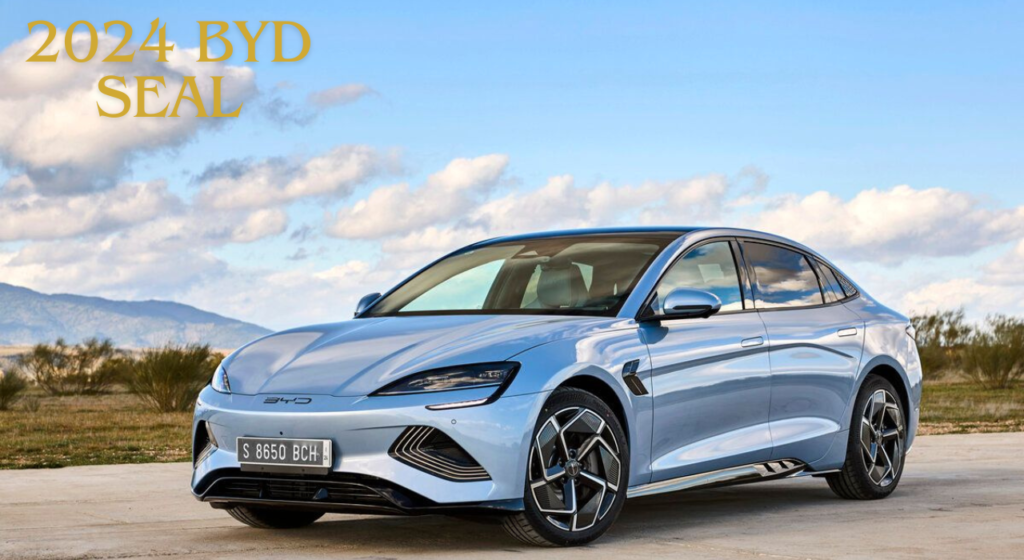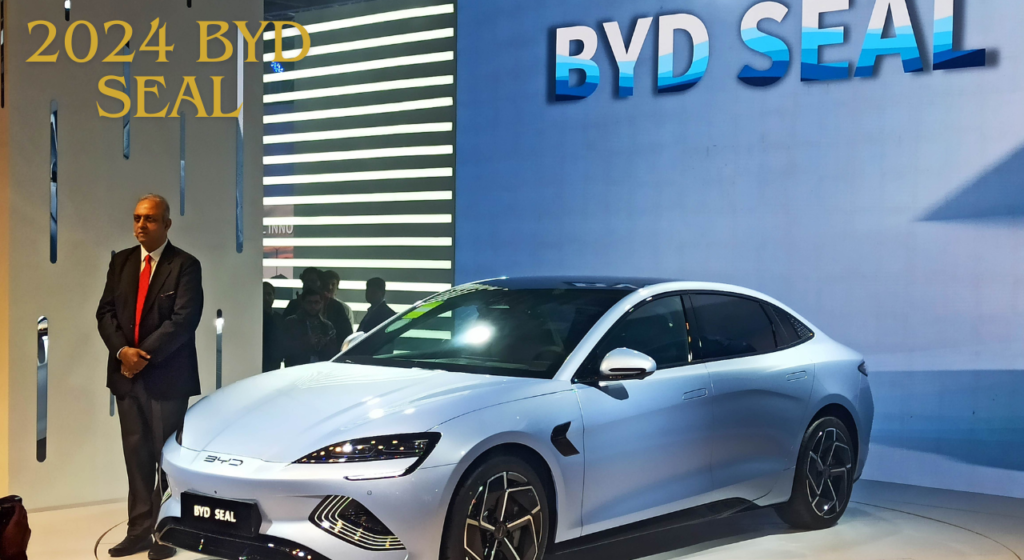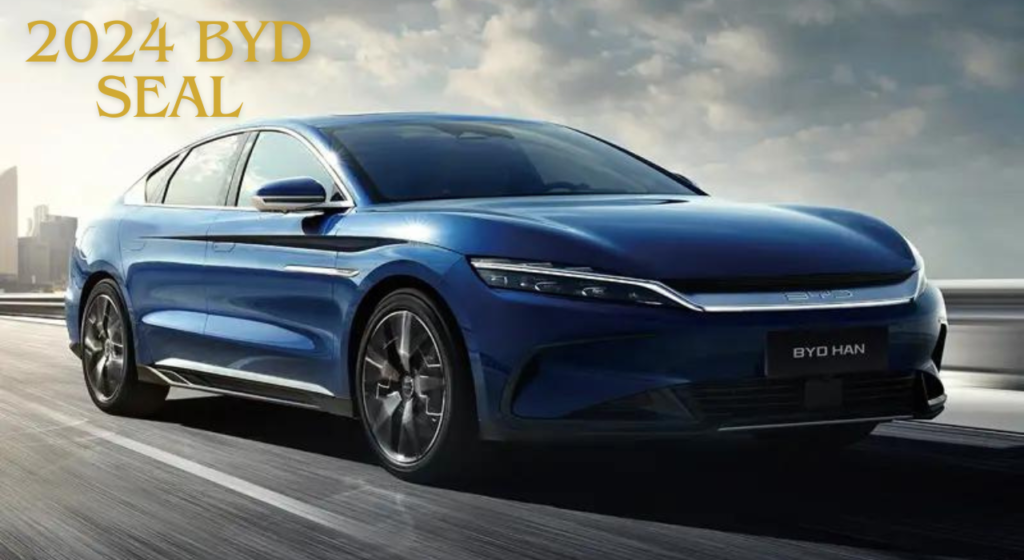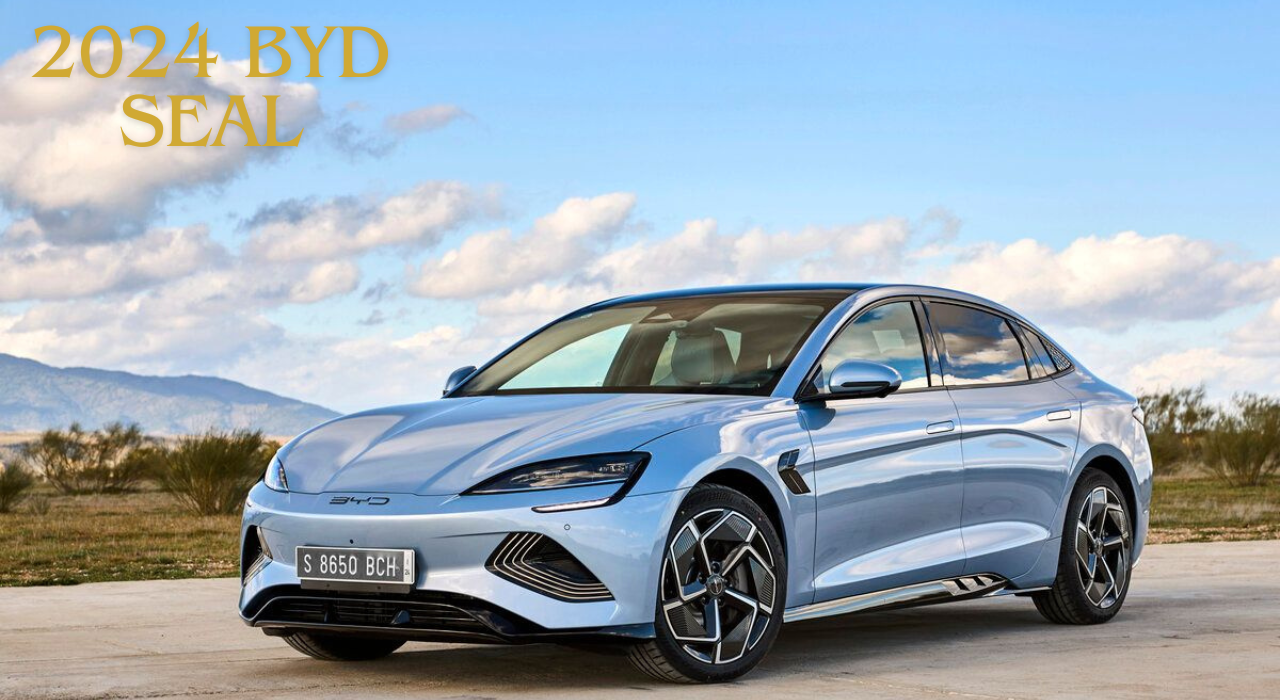The 2024 BYD Seal is creating quite a buzz globally, especially during its launch in Mexico. While it might not create the same ripples in the U.S., this sedan is making a significant statement and aims to compete with the Tesla Model 3. Surprisingly, BYD executives in Mexico see it as a potential choice for buyers interested in sport sedans like the BMW M3. After a day of test driving on the highways around Mexico City, it’s evident why the BYD Seal is gaining ground against Tesla’s EV sales. The impressive features and performance of the Seal make it a compelling option for those looking for an alternative in the electric sedan market.
Beyond its sleek design, the BYD Seal boasts impressive performance features. The all-wheel-drive, dual-motor variant can accelerate from 0 to 62 mph (100 km/h) in just 3.8 seconds and achieve a remarkable 323 miles on a single charge, thanks to its 82.6-kWh battery. The base model, with a single motor and rear-wheel drive, covers 285 miles with its 61.4-kWh battery and reaches 62 mph in 7.5 seconds, as stated by BYD.
During our test on the track, we had the opportunity to experience both models. However, the majority of our time was spent driving the rear-wheel-drive model on the winding highways around Mexico City. It became evident that the BYD Seal can compete admirably with the Tesla Model 3 and other European cars in terms of performance. This electric sedan’s capabilities make it a compelling choice for those seeking an exhilarating driving experience with an impressive range on a single charge.

BYD, a Chinese automaker, has become a major player in the electric vehicle (EV) and plug-in hybrid electric vehicle (PHEV) market. Originally focused on manufacturing batteries for phones, BYD has evolved into a significant disruptor in the automotive industry. Despite being in the car business for decades, the company now exclusively produces PHEVs and EVs.
While BYD initially gained prominence in China, it has recently expanded its reach to Europe, Mexico, Brazil, and various markets in Asia and the Americas. Notably, the brand has a manufacturing facility in northern Los Angeles County, specializing in the production of buses. However, as of now, BYD has no plans to enter the U.S. passenger vehicle market. This strategic decision reflects the company’s focus on specific segments of the automotive industry while contributing to its global presence.
Assessing the Interior Space of the BYD Seal in 2024
The moment you settle into the cabin of the BYD Seal, it becomes clear that meticulous attention has been given to create an environment that is both sophisticated and notably special. Any preconceived notions about Chinese cars being solely cheap and cheerful can be set aside, as the Seal’s interior stands out above such assumptions.
At the heart of the cabin is a 15.6-inch touchscreen, a signature feature in every BYD. Impressively, it can rotate through 90 degrees, offering the flexibility to display in either landscape or portrait mode. While it may serve as a captivating party trick initially, most users will likely opt for the user-friendly landscape mode for day-to-day convenience.
The choice of materials in the cabin, whether plastic, ‘leather’, or the luxurious suede-like material generously incorporated, is not just pleasing to the eye but also soft to the touch, exuding a distinct sense of prestige.
The seats, adorned with contrasting piping and a quilted pattern, provide a comfortable and supportive experience with commendable bolstering. They are not only power-adjustable but also equipped with heating and cooling features, ensuring optimal comfort in both cold and hot weather. On a particularly warm Sydney day, the seat cooling function proved to be a real blessing.
The premium feel continues with the leather-wrapped steering wheel, offering a substantial and comfortable grip. It surrounds the 10.25-inch driver display, configurable to present various driving data. While the interface may initially pose a challenge, requiring a series of presses on the steering-wheel-mounted controls, once mastered, it becomes second nature. Overall, the BYD Seal’s interior successfully combines aesthetics with practicality, creating an environment that surpasses expectations.
In terms of practicality, the BYD Seal doesn’t disappoint. Upfront, you’ll find a duo of cupholders, a wireless charging pad for two devices, a spacious central storage bin, door pockets capable of accommodating bottles, and a larger space under the center console perfect for handbags or smaller backpacks.
The clever battery integration in the second row is a standout feature. The battery’s compact design allows for ample foot, knee, and legroom. However, the panoramic glass roof, coupled with the Seal’s sloping roofline, slightly affects headroom. For my 173cm frame, it felt perfectly comfortable, but individuals over 183cm might find it a tad cramped.
The back seats themselves offer a plush and cozy feel, ideal for those extended road trips. The middle seat, common in many new cars, is less comfortable due to a firm base and backrest, courtesy of the Seal’s fold-down armrest housing two cupholders. This seat is also slightly elevated, impacting headroom.
Moving on to amenities in the second row, you’ll find air vents (though no separate climate controls), a small storage cubby under the air vents, generous door pockets, and two USB charging points—one Type-A and one Type-C. The outboard seats come with ISOFIX child seat mounts, and all three seats feature top-tether anchor points.
The powered tailgate grants access to the boot, which, while not exceptionally large at 400 liters, expands with the second row folded in a 60:40-split fashion. BYD doesn’t specify the expanded cargo area, but there’s a convenient nook under the boot floor for storing the Seal’s charging cables, along with a compartment housing a tyre inflation kit.
Additionally, there’s an extra 50 liters of cargo capacity under the Seal’s bonnet, easily accommodating a carry-on suitcase, a larger backpack, or a couple of bags of groceries. The BYD Seal excels in providing practical and thoughtful features for a comfortable and convenient driving experience.
Let’s delve into the 2024 BYD Seal’s performance and key specifications:
- Seating Capacity: The Seal comfortably accommodates five passengers.
- Boot Volume: With the seats up, the boot offers a capacity of 400 liters. Additionally, there’s an extra 50 liters of storage space in the front trunk, providing ample room for your belongings.
- Dimensions:
- Length: The Seal stretches out to 4800mm, ensuring a spacious interior.
- Width: With a width of 1875mm, the Seal strikes a balance between agility and interior roominess.
- Height: Standing at 1460mm, the Seal maintains a sleek and aerodynamic profile.
- Wheelbase: The generous wheelbase of 2920mm contributes to a stable and comfortable ride.
These performance metrics highlight the BYD Seal’s thoughtful design, combining practicality and style to enhance your driving experience.
Assessing BYD Seal’s Connectivity with Apple CarPlay and Android Auto
Let’s explore the technology and user interface features in the 2024 BYD Seal:
- Impressive Touchscreen: The centerpiece of the Seal’s tech features is a sizable 15.6-inch touchscreen. Its clean layout, sharp graphics, and generous size create a visually appealing interface. Supporting wireless Apple CarPlay and Android Auto, it also caters to those who prefer wired connections with USB plugs—featuring both Type-A and Type-C—conveniently located under the center console.
- Smartphone Projection: Testing the wired Apple CarPlay, we experienced seamless functionality with no glitches. The projection effectively utilizes the entire width of the central screen, a standout performance compared to other brands with similarly large screens.
- Screen Rotation Gimmick: The screen’s ability to rotate 90 degrees for portrait orientation adds a touch of novelty. While it might impress your friends, it’s more of a fun gimmick than a practical feature.
- Entertainment and Navigation: The system includes inbuilt satellite navigation, and radio options cover FM and DAB+. However, it’s worth noting the absence of AM reception, which might be a concern for those relying on it in rural areas or for emergency alerts.
- Touchscreen Dominance: Unfortunately, most of the Seal’s functions, including climate settings and advanced safety systems, are primarily accessed through the touchscreen. While modern, this approach may be considered less intuitive and more distracting than the traditional physical controls.
- Voice Activation: The ‘Hi BYD’ voice-activated commands are available, but like many systems, responsiveness can be hit or miss.
- Remote Access via App: Keeping up with contemporary trends, the BYD Seal allows remote access through the BYD Connect app. Owners can unlock and lock the car, monitor charging status, and use climate controls to condition the interior before getting in.
The tech features of the BYD Seal showcase a blend of modern conveniences and some aspects that might require a bit of adjustment for users accustomed to more traditional interfaces.
Exploring the Safety Features of the BYD Seal
Safety is a top priority for the BYD Seal range, earning a prestigious five-star ANCAP safety rating in 2023. This recognition comes from rigorous testing conducted by ANCAP’s European counterpart, Euro NCAP.
The assessment breakdown highlights the Seal’s commitment to passenger safety:
- Adult Occupant Protection: An impressive 89% score reflects the Seal’s dedication to keeping adults safe in various scenarios.
- Child Occupant Protection: The Seal scored a solid 87%, emphasizing its effectiveness in safeguarding younger passengers during journeys.
- Vulnerable Road User Protection: Achieving an 82% rating underscores the Seal’s consideration for the well-being of pedestrians and cyclists on the road.
- Safety Assistance Technology: With a 75% rating in safety assistance technology, the Seal demonstrates its commitment to incorporating advanced features for enhanced driving safety.
These results affirm the BYD Seal’s excellence in safety across different categories, providing peace of mind for both drivers and passengers alike.
Let’s take a closer look at the safety technology integrated into the BYD Seal:
- Advanced Driver Assist Systems (ADAS): At the core of the Seal’s impressive five-star safety rating is a comprehensive suite of advanced driver assist systems. This includes features such as a rear-view and 360-degree camera, autonomous emergency braking (AEB), lane-keep assist, adaptive cruise control, blind-spot monitoring, front and rear cross-traffic alert with braking, door exit warning, traffic sign recognition, and automatic high beams.
- Airbag System: Ensuring occupant safety, the BYD Seal is equipped with a total of nine airbags, strategically placed to cover both rows of passengers. This includes front-centre and rear-side airbags.
While the commitment to advanced safety features is commendable, our hands-on experience with the Seal did bring forth a couple of concerns, particularly regarding the AEB system. On two occasions, false positives were triggered – once under a bridge where the system mistook a pylon for a vehicle, and another when a semi-trailer made a slight lateral movement within its lane. In both instances, the AEB applied the brakes, a somewhat disconcerting experience when there was no apparent obstacle.
Similarly, the lane-keeping assist system proved to be a bit too eager, prompting the need for manual intervention. The speed-sign recognition, although a valuable feature, became a tad annoying with its frequent alerts. Disabling these features through the touchscreen proved to be the solution, although it required adjustment each time the vehicle started up.
It’s worth noting that speed-sign recognition systems, a common feature across various car manufacturers, can sometimes pick up irrelevant signs, such as off-ramp speed limits or signs on the back of buses, leading to occasional inconvenience.
In summary, while the BYD Seal is well-equipped with advanced safety technologies, our experience highlighted some nuances that users may want to be aware of, particularly in the context of AEB and certain driver assist features.
Budget-Friendly Insights into BYD Seal Ownership
Let’s dive into the warranty and maintenance details for the BYD Seal, along with some insights on insurance:
- Warranty Coverage:
- BYD offers a standard six-year/150,000km warranty for the Seal.
- The battery, a crucial component in an electric car, is covered for an extended eight years or up to 160,000km.
- Warranty Considerations:
- While the battery warranty aligns with industry norms, the vehicle warranty may seem a bit on the lower side, especially in terms of distance. It’s important to note that BYD places conditions on its vehicle warranty, with different components like suspension and infotainment receiving varying coverage. You can find the detailed terms and conditions here.
- Service Intervals and Costs:
- Regular service intervals for the BYD Seal are set at every 12 months or 20,000km, whichever comes first.
- The Standard Service Plan eases the burden with a complimentary first workshop visit at three months/5000km.
- Subsequent service costs are as follows: $189 for the first annual service (20,000km), $370 for the 24-month/40,000km service, $189 for the 36-month/60,000km service, $447 for the 48-month/80,000km service, and another $189 for the 60-month/100,000km service.
- The total for three years’ scheduled servicing amounts to $748, while a five-year plan costs $1384. Quite reasonable when considering routine maintenance.
- Insurance Insights:
- Comprehensive insurance for the BYD Seal is estimated at $2249 annually. This figure is based on a comparative quote for a 35-year-old male driver residing in Chatswood, NSW. Keep in mind that insurance costs can vary depending on factors like your location, driving history, and personal circumstances.
In summary, BYD provides a solid warranty package for the Seal, with reasonable service costs and a complimentary initial service. The insurance estimate gives a ballpark figure, but it’s advisable to seek personalized quotes based on your individual situation.
- Warranty Coverage:
- The BYD Seal comes with a standard six-year warranty, providing peace of mind for up to 150,000km.
- The battery, a crucial component in electric cars, enjoys an extended warranty of eight years or up to 160,000km.
- Service Intervals and Costs:
- Routine maintenance for the BYD Seal is scheduled every 12 months or 20,000km, whichever comes first.
- The Standard Service Plan includes a complimentary first workshop visit at three months/5000km.
- Subsequent service costs are budget-friendly, totaling $748 for three years or $1384 for a five-year plan.
In summary, the BYD Seal not only delivers solid performance but also offers a robust warranty package and affordable maintenance plans, making it a sensible choice for drivers looking for reliability and cost-effectiveness.

Evaluating the Environmental Impact of the BYD Seal
Let’s delve into the energy consumption and charging capabilities of the all-wheel-drive BYD Seal Performance:
- Energy Consumption:
- In European WLTP testing, the estimated energy consumption for the all-wheel-drive BYD Seal Performance stands at 18.2kWh per 100km.
- Our hands-on experience covering 334km of mixed driving conditions recorded a slightly more efficient 16.9kWh/100km.
- Notably, the ‘Past 50km’ gauge settled at 15.2kWh/100km upon returning the car, with observed lows as impressive as 13kWh on the motorway.
- Battery and Charging:
- The BYD Seal Performance boasts an 82.6kWh battery that accommodates both AC and DC charging.
- The maximum charging rates are 7.2kW for AC and an impressive 150kW for DC.
- Charging Times:
- Using a 7kW home-installed wallbox, a full recharge from zero to 100 percent takes approximately 11.5 hours, providing a convenient overnight charging option.
- Opting for a 50kW public charger significantly reduces charging time to 52 minutes, covering the range from 10 to 80 percent.
- For those in a hurry, a fast charger shortens the time to just 26 minutes, spanning from 30 to 80 percent. It’s worth noting that while faster chargers are available, the BYD Seal maxes out at 150kW, meaning a 350kW super-charger won’t result in quicker charging.
In summary, the BYD Seal Performance impresses with its efficient energy consumption, and the flexibility of charging options makes it a practical choice for various driving needs. Whether opting for the convenience of home charging or the speed of public fast chargers, the Seal provides adaptability to suit diverse charging preferences.

The BYD Seal’s Journey as a Driver’s Delight
Let’s explore the exhilarating performance and driving dynamics of the flagship BYD Seal Performance:
- Powerful Acceleration:
- The Seal Performance is a powerhouse, featuring two electric motors—one at each axle—delivering a combined 390kW and 670Nm. This dynamic duo propels the Seal Performance from 0 to 100km/h in a jaw-dropping 3.8 seconds. Remarkably, this feat is achieved despite the Seal Performance carrying a weighty 2185kg. To flaunt its prowess, the tailgate proudly boasts a 3.8s badge.
- Driving Dynamics:
- Beyond its impressive straight-line speed, the Seal Performance impresses with its versatility in handling more leisurely driving scenarios. Whether smoothly accelerating from a standstill at traffic lights or merging onto highways, the Seal Performance exhibits a spritely yet predictable surge of speed that never feels unwieldy.
- Ride Comfort and Suspension:
- Despite the firm side of the ride spectrum, the Seal maintains a well-balanced feel. Equipped with passive dampers, the top-spec variant boasts “semi-active suspension” thanks to variable-frequency dampers. This intelligent system adjusts damping for a firmer ride on smoother roads while softening over rough terrain, offering a comfortable ride that absorbs impacts without feeling overly jarring.
- Drive Modes:
- The Seal Performance caters to various driving preferences with four drive modes—Eco, Normal, Sport, and Snow. While Sport mode sharpens throttle response and steering weight, Normal mode is perfectly suitable for most conditions and tends to be the preferred choice.
- Cabin Comfort and Noise Levels:
- Cabin comfort is a priority, with double-glazed windows and effective sound-deadening keeping road noise at bay. This attention to detail ensures a pleasant and quiet interior environment.
- Regenerative Braking:
- The Seal Performance incorporates regenerative braking, harnessing energy from braking and coasting to recharge the battery. While the default setting is relatively low, more aggressive regenerative braking can be selected through the touchscreen. Notably, there is no single-pedal driving mode.
In summary, the BYD Seal Performance delivers an exhilarating driving experience with impressive acceleration and a well-balanced ride. Whether you’re in the mood for spirited driving or a more refined journey, the Seal Performance adapts seamlessly, making it a versatile and enjoyable electric vehicle.
Let’s delve into the key specifications of the 2024 BYD Seal Performance, breaking down its impressive features in an easily digestible format:
- Propulsion System:
- The Seal Performance is equipped with dual electric motors that power all four wheels, making it an agile all-wheel-drive vehicle.
- Performance Metrics:
- With a robust power output of 390kW and an impressive torque of 670Nm, the Seal Performance promises an exhilarating driving experience.
- Transmission and Drivetrain:
- The seamless power delivery is managed by a single-speed automatic transmission, contributing to a smooth and responsive ride.
- Power-to-Weight Ratio:
- Boasting a power-to-weight ratio of 178.5kW per ton, the Seal Performance demonstrates a remarkable balance between power and weight.
- Weight and Build:
- Weighing in at 2185kg (kerb weight), the Seal Performance maintains its agility despite its substantial build.
- Spare Tire and Turning Circle:
- In the event of a flat, the Seal Performance is equipped with a practical tyre repair kit. Additionally, its nimble turning circle of 11.4 meters enhances maneuverability in various driving conditions.
These specifications underscore the Seal Performance’s commitment to delivering a powerful yet agile driving experience, making it a noteworthy contender in the electric vehicle landscape.
Weighing the Options for Potential BYD Seal Buyers
The BYD Seal Performance stands out as an impressive electric car, delivering a well-rounded package with a thoughtfully designed interior. While its straight-line acceleration is undoubtedly attention-grabbing, what truly sets the Seal apart is its versatility as a tourer. Whether navigating through city traffic or cruising along open highways, the Seal proves equally adept in both scenarios.
While our experience has focused on the flagship version, there’s a strong indication that the entry-level Dynamic and mid-spec Premium variants should offer a similarly compelling driving experience. In essence, the BYD Seal has positioned itself as a genuine and more affordable contender in the electric car market, presenting a credible alternative to the Tesla Model 3.
